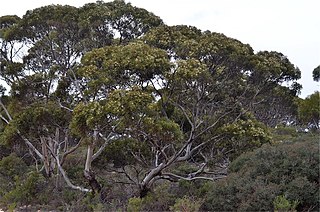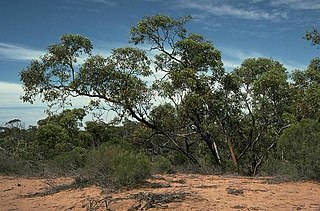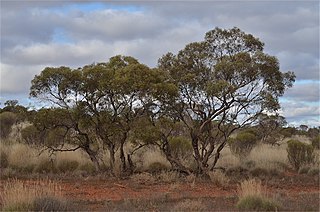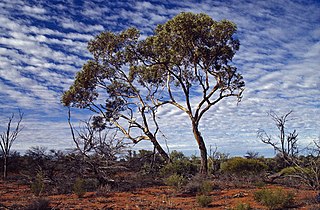
Eucalyptus lansdowneana, commonly known as the crimson mallee or the red-flowered mallee box, is a species of slender stemmed, straggly mallee that is endemic to a restricted area of South Australia. It has rough, fibrous or flaky bark at the base, smooth, grey over creamy-white bark, lance-shaped adult leaves, flower buds in groups of seven, crimson flowers and barrel-shaped fruit.

Eucalyptus dumosa, commonly known as the white mallee, dumosa mallee, or Congoo mallee, is a species of mallee that is endemic to south eastern Australia. It usually has rough, flaky grey bark on the lower trunk, smooth bark above, lance-shaped to curved adult leaves, flower buds in groups of seven, white flowers and cup-shaped, cylindrical or barrel-shaped fruit.

Eucalyptus porosa, commonly known as mallee box, Quorn mallee or water mallee, is a species of mallee or a tree that is endemic to southern Australia. It has rough, fibrous or flaky bark on the trunk and larger branches, smooth greyish bark above, lance-shaped adult leaves, flower buds in groups of seven, white flowers and barrel-shaped or shortened spherical fruit.

Eucalyptus foecunda, commonly known as narrow-leaved red mallee, Fremantle mallee or coastal dune mallee, is a species of plant in the myrtle family that is endemic to Western Australia. It has rough bark on the trunk, smooth bark above, narrow lance-shaped adult leaves, flower buds in groups of nine or eleven, creamy white flowers and cup-shaped fruit. It was previously included with the more widespread Eucalyptus leptophylla.

Eucalyptus gracilis, commonly known as yorrell, snap and rattle, red mallee, white mallee or kong mallee, is a species of mallee or small tree endemic to Australia, where it is found in south-western New South Wales, Victoria, South Australia and Western Australia. It has smooth white bark, usually with rough, fibrous or flaky bark on the lower stems, linear to narrow lance-shaped adult leaves, flower buds in group of between seven and eleven and cup-shaped, cylindrical or barrel-shaped fruit.

Eucalyptus intertexta, commonly known as inland red box, western red box, gum coolibah or the bastard coolibah, is a species of tree that is endemic to central Australia. It has rough, fibrous or flaky bark on the base of the trunk, smooth white to brownish bark above, lance-shaped adult leaves, flower buds in groups of seven on the ends of branchlets, white flowers and cup-shaped to hemispherical fruit.
Eucalyptus gypsophila, also known as the kopi mallee, is a species of mallee that is native to Western Australia and South Australia. It has rough, flaky bark on the lower part of the trunk, smooth light grey bark above, lance-shaped adult leaves, flower buds mostly in groups of between seven and eleven, creamy white flowers and conical to cylindrical fruit.

Eucalyptus mannensis, commonly known as Mann Range mallee, is a species of mallee that is native to Western Australia, South Australian and the Northern Territory. It has rough bark at the base of the trunk, smooth bark above, narrow lance-shaped adult leaves, flower buds in groups of between seven and eleven, creamy white flowers and hemispherical fruit.

Eucalyptus platycorys, commonly known as Boorabbin mallee, is a species of mallee, rarely a small tree, that is endemic to Western Australia. It has rough, dark grey, fibrous and flaky bark on the trunk, smooth greyish bark above, lance-shaped adult leaves, flower buds usually in group of three, creamy white flowers and cup-shaped to cylindrical fruit.
Eucalyptus semota, commonly known as marymia mallee, is a species of mallee or small tree that is endemic to a small area in central Western Australia. It has rough, flaky to fibrous bark on the trunk, smooth grey or brown bark above, linear to narrow lance-shaped leaves, flower buds in groups of seven or nine, white flowers and conical to cup-shaped fruit.

Eucalyptus cyanophylla, commonly known as the Murraylands mallee, blue-leaved mallee or ghost mallee, is a species of mallee that is endemic to southern Australia. It has mostly smooth bark, greyish blue, lance-shaped or curved adult leaves, flower buds in groups of seven, white flowers and conical, cup-shaped or barrel-shaped fruit.

Eucalyptus yumbarrana, commonly known as the Yumbarra mallee is a species of mallee that is endemic to South Australia. It has rough, flaky bark on the lower trunk, smooth bark above, egg-shaped to lance-shaped adult leaves, flower buds in groups of seven, creamy white to yellow flowers and shortened spherical to cup-shaped fruit.

Eucalyptus canescens, commonly known as the Ooldea Range mallee or Beadell's mallee, depending on subspecies, is a species of mallee that is endemic to southern Australia. It has rough bark from the base of the trunk to the thicker branches, smooth bark on the thin branches, egg-shaped to lance-shaped adult leaves, flower buds in groups of between seven and eleven, creamy white flowers and smooth cup-shaped to conical, and sometimes ribbed fruit.
Eucalyptus capitanea, commonly known as the desert ridge-fruited mallee, is a species of mallee that is endemic to South Australia. It often has rough, flaky bark on the lower part of the trunk, smooth bark above, lance-shaped adult leaves, ribbed, oval flower buds in groups of seven, cream-coloured flowers and ribbed, urn-shaped fruit.
Eucalyptus longissima is a species of mallee or small tree that is endemic to the south-west of Western Australia. It has rough, fibrous or stringy bark on the trunk, smooth greyish brown bark above, glossy green, lance-shaped adult leaves, flower buds in group of between seven and thirteen, white flowers and shortened spherical fruit.
Eucalyptus orthostemon, also known as diverse mallee, is a species of mallee that is endemic to the south-west of Western Australia. It has smooth coppery and greyish bark, linear adult leaves, oval to spindle-shaped buds in groups of seven, creamy white flowers and conical to cup-shaped fruit.

Eucalyptus socialis subsp. eucentrica, commonly known as the inland red mallee, is a subspecies of mallee that is endemic to inland Australia. It usually has rough bark on the base of the trunk, smooth bark above, lance-shaped adult leaves, flower buds in groups of between seven and eleven, pale creamy yellow flowers and barrel-shaped to urn-shaped or spherical fruit.

Eucalyptus socialis subsp. socialis, commonly known as the summer red mallee, is a subspecies of mallee that is endemic to inland south-eastern Australia. It usually has rough bark on the base of the trunk, smooth bark above, lance-shaped adult leaves, flower buds in groups of between seven and eleven, pale creamy white flowers and barrel-shaped to urn-shaped or spherical fruit.

Eucalyptus socialis subsp. victoriensis, commonly known as the red mallee, is a subspecies of mallee that is endemic to southern inland Australia. It usually has rough bark on the base of the trunk, smooth bark above, lance-shaped adult leaves, flower buds in groups of between seven and eleven, pale creamy yellow flowers and barrel-shaped to urn-shaped or spherical fruit.
Eucalyptus socialis subsp. viridans, commonly known as the green-leaved red mallee, is a subspecies of mallee that is endemic to south-eastern Australia. It usually has rough bark on the base of the trunk, smooth bark above, lance-shaped adult leaves, flower buds in groups of between seven and eleven, pale creamy yellow flowers and barrel-shaped to urn-shaped or spherical fruit.
















